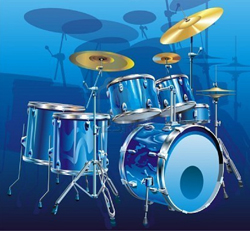
Shell Material
Probably out of all the parameters described here, the material used to make the drum shell is the most responsible for tone of the drums. Here are the most commonly found drum shell materials.
Generally speaking, maple is the most prized construction material by drummers, primarily because the sound is so even across the drum frequency spectrum. It’s expensive and becoming more difficult to get since it’s a slow growth tree.
Mahogany is another slow growth wood that is becoming increasingly hard to find. While true US or Honduran mahogany is considered the best, other woods from the Philippines, Southeast Asia, China and Malaysia are sometimes labeled mahogany simply because they have the same look as the US or Honduran wood, but they don’t sound the same since their density varies from the real wood. Mahogany drums sound warmer than maple since the low end is increased.
Birch is a very dense wood, which, thanks to its hardness, results in a brighter drum with a lot less low end than Maple.
Poplar is a fast growing tree, which translates into cheaper wood and inexpensive drum kits. It has a sound very similar to birch, with a bright top end with less bottom.
Basswood is also a fast growing tree, resulting in inexpensive kits, but exhibits an increased low end that’s similar to mahogany.
Luaan is an Asian tree that provides the least expensive wood available. It’s very strong and accepts a stain very well so it generally looks good. It also has a warmer sound with less top end, similar to mahogany.
Shell Interior
Although it’s not widely known, the interior of the drum shell has a lot to do with the pitch of the drum. A rough interior produces in a less resonant drum, since the roughness breaks up the interior reflections. A smooth interior results in a more resonant drum, which means it’s easier to tune and control.
Bearing Edges
Maybe the least understood of all the things that go into giving a drum its tone is the bearing edges of the shell. That means the cut at the edge of a drum shell where the hoops are attached. The way the bearing edge is cut can not only affect the pitch of the drum, but the tuning as well. The sharper the cut, the brighter the drum.
The degree at which the edge is cut makes all the difference in the sound of the drum. A sharp 45-degree angled cut will result in a long sustain with bright overtones. A 30-degree cut will provide less of a high-pitched ring. Rounded edges produce a muted, poor tone. All bearing edges must be flat and true with the exact same degree of cut.
Hoops
The type of hoop and the number of lugs used to seat the drum heads also determines how the drum will sound. In general, the thicker the hoop, the easier the drum will be to tune. Fewer lugs provide more complex overtones.
Stamped hoops are made from a variety of metals, all of which affect the tone a bit differently, but most drummers feel they get a warmer tone from die cast hoops. Aluminum gives a high pitch while brass provides more overtones.
Die cast hoops are generally both thicker and stronger than stamped hoops so the drum becomes easier to tune. There are fewer overtones as a by-product.
Wood hoops come in different thicknesses, so they can be made to sound like either a stamped or a cast hoop, only brighter.
Drum construction plays a vital importance in how a drum will sound, and until it sounds great acoustically, it will never sound great under a microphone.
(This is a summary of Chapter 1 of The Drum Recording Handbook that engineer Dennis Moody and I wrote where we find out just why drums acoustically sound the way they do.)
Bobby Owsinski is an author, producer, music industry veteran and technical consultant who has written numerous books covering all aspects of audio recording. For more information be sure to check out his website and blog.
